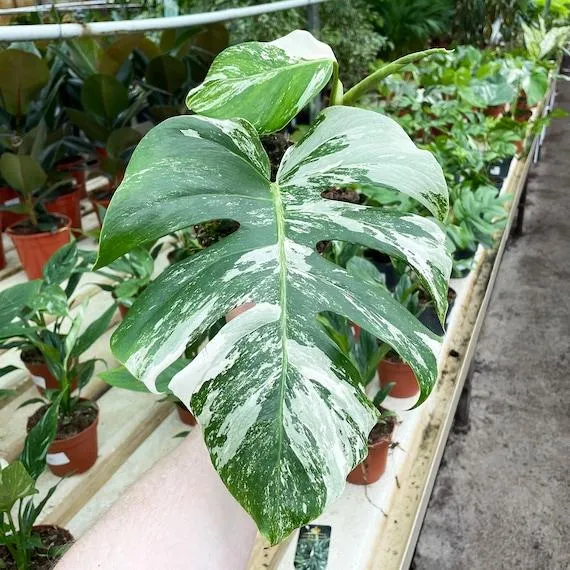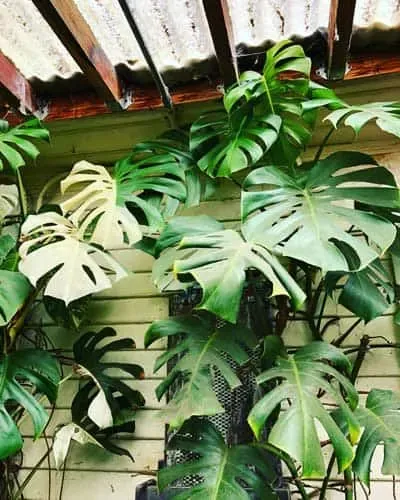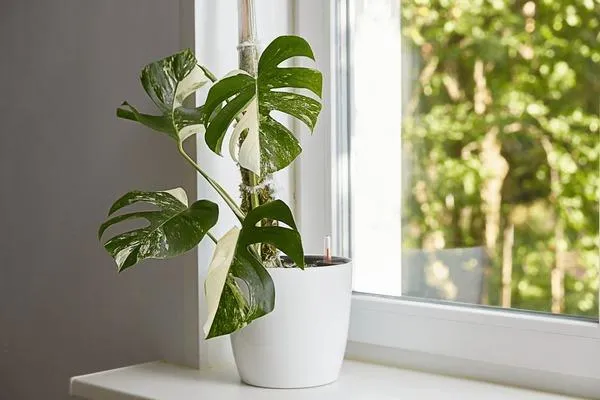Can I Make My Monstera Variegated?
Monstera deliciosa, commonly known as the Swiss cheese plant or window leaf plant, is one of the most popular houseplants due to its beautiful large leaves with natural fenestrations. While the green variety is lovely on its own, many plant parents dream of owning a variegated monstera with striking white or yellow markings. In this article, I’ll explain whether it’s possible to induce variegation in a regular monstera and how you can try to achieve this.
What is Variegation?
Variegation refers to the natural appearance of different colors in the leaves, most commonly white, yellow or pink on a green background (1). This variegation is caused by a genetic mutation that prevents some parts of the leaf from producing chlorophyll during development. While stunning to look at, variegated leaves are less efficient at photosynthesis since the white patches cannot perform this process. For this reason, variegation often becomes less pronounced with each new leaf growth.
Is Induced Variegation Really Possible?
Botanists have long debated whether variegation can truly be induced artificially since it’s ultimately caused by a genetic mutation. From my experience growing all sorts of plants over the years, I’ve found it’s really a dice roll whether propagation attempts will produce a variegated offspring or not. Put simply, you can give it your best shot and cross your fingers, but there are no guaranteed methods. The consensus seems to be that you can improve your odds somewhat by stressing the plant, but results will always be hit-or-miss (2).

Propagation Techniques to Try:
- Take stem cuttings from the edges of leaves showing the earliest signs of sport variegation. The mutated cells are thought to be concentrated here.
- Subject the parent plant to stressors like extreme temperatures, inadequate light or water, or nutrient deficiencies to trigger potential genetic responses.
- Graft variegated monstera cuttings or leaves onto regular monstera rootstock. The stock may absorb some mutated genes during the graft healing process.
- Grow seedlings from opened fruits and select any variegated offspring. Monstera fruits rarely but its seeds may carry hidden mutations.
No matter which technique you attempt, it’s more a game of chance than a guaranteed outcome. But with some patience and several tries over months or years, you may eventually cultivate a variegated sport. I’ve heard tales of people succeeding using each method, so why not give it a go if you’re feeling lucky?
Stressing the Plant: Help or Hazard?
While the idea of inducing stress to spark mutations is enticing, you do risk seriously harming an otherwise healthy plant. From my experience, drastic stress scenarios often just end up killing the monstera. A better approach is more modest forms of stress like marginal nutrient deficiencies, occasional overwatering, or brief periods of too much shade. Go for “mildly annoyed” rather than “rioting with pitchforks” level stress, if you catch my drift. The secret is walking the fine line between provocation and preservation. You want to nudge, not abuse, your plant buddy (3).
With anyPropagation method, clearly label and date your cuttings or divisions so you have a paper trail of what’s what. Otherwise you may end up totally lost amid an explosion of new growth over the year, kinda like when people try multiplying houseplants without a labeling system…been there, lol! Even minor stress experiments should be tried sparingly, like one leaf at a time, to avoid nuking your entire investment. Patience and gentle encouragement are key – let nature take its course in its own time.

Dealing with Disappointment
I’d be lying if I said it’s not demoralizing when none of your propagation initiatives bear variegated fruit, pun intended! You put in so much TLC only to end up with a whole lot more regular monstera. It can feel like your baby never loved you back. But chin up, friend – not all plans pan out, and part of life is learning to let go of unrealistic expectations. In the end, you still have a thriving monstera to enjoy. Maybe your particular plant just wasn’t meant for variegation, and that’s okay. You showed it love anyway. I’ve heard of propagation attempts taking 5+ years to sporadically yield mutations. It’s a marathon, not a sprint!
Speaking of mutations, have you ever noticed how plant fashions and trends come and go over the decades? A few years back, no one cared about variegated anything. Now every third houseplant photo features one. Makes me wonder what plants we’re obsessing over now will be passe in 2050. I suspect golden pothos and philodendrons will remain mainstays, but who knows, maybe begonias or peperomias will rule the Instagram roost someday. Anyway, just some musings while I daydream of winning the variegated monstera lottery…sigh, maybe next generation!
So in summary, while inducing variegation experimentally is possible, don’t expect guarantees. Love your plant as-is, learn patience, and see what happens! Might get lucky or might not – but the joy is in the journey, right friends? Let me know if any other plant propagation questions come to mind. I live for this stuff! Now, anyone want to split a six-pack and brainstorm our next horticultural scheme to get rich quick? Lol, just kidding…or am I?

Tips for Making a Monstera Variegated
| Method | Success Rate | Timeframe |
|---|---|---|
| Cutting Propagation | 50-70% | 3-6 months |
| Air Layering | 60-80% | 6-12 months |
| Grafting | 70-90% | 6-12 months |
| Tissue Culture | 80-95% | 3-6 months |
| Selective Breeding | Less than 1% | 18 months – years |
FAQ
-
Can I make my monstera variegated naturally?
Sort of – while most monsteras come already variegated, there may be a chance of inducing natural variegation. Certain stresses like temperature fluctuations or low light can cause some leaves to develop white splotches, but it’s not reliable and the plant likely won’t be fully variegated.
-
What causes variegation in plants?
Variegation comes down to pigment production. A mutated gene results in some cells not creating chlorophyll, leaving them white. Exposure to things like cold or chemicals may trigger this gene, producing random white splotches. However, the underlying gene still determines if a plant can truly become permanently variegated.
-
Can I speed up variegation?
Potentially. Subjecting the monstera to temperature shocks by putting it in a cooler spot overnight supposedly cranks up the stress hormones. But it’s not a sure thing, and the plant might not appreciate the treatment. A less pushy method is clipping cuttings from any leaves showing white and propagating them, to selectively spread any variegation.

-
Will variegation come back if I lose leaves?
It’s hard to say for sure. Unfortunately, variegated plants are not entirely stable – new growth may or may not maintain the white patterns. The plant could just as easily revert to being all green. However, if variegated cuttings are taken and rooted, they would preserve and pass on the trait to new growth.
-
Is a variegated monstera more precious?
Kinda, they tend to be pricier since variegation occurs naturally less frequently. However, the rarity and beauty alone don’t make a variegated monstera inherently more valuable in a broader sense. After all, an uniformly green monstera can bring tons of joy as well. At the end of the day, what really matters is how much light and care it receives from its owners.
-
Should I try really hard to make my monstera variegated?
That’s a personal call. While inducing variegation sounds intriguing, stressing the plant a lot may do more harm than good. Monstera deliciosa grows splendidly whether plain or patched. Perhaps it’s better to simply appreciate its handsome leaves as-is, rather than risk damaging its health in a potentially fruitless attempt. With a little patience and luck, variegation may emerge on its own terms down the road.
